- Sustainability TOP
- Environment
- Resource Recycling Promotion
Resource Recycling Promotion
Basic Approach
The transition to a sustainable society requires a shift from the linear economic system, which emerged from a mass production and mass consumption-based economic model, to a circular economic system. The Isuzu Group has set a goal of achieving 100% recycling of waste and end-of-use vehicles as part of the Aspiration in Isuzu Environmental Vision 2050. We are advancing initiatives to realize a circular economy by focusing on resource conservation, reuse, and circulation throughout our business operations to maximize added value.
| Isuzu Environmental Vision 2050 | 2030 Environmental Roadmap | |
|---|---|---|
| Aspiration | 2030 Challenge | Global Action |
100% recycling of waste and end-of-use vehicles |
|
|
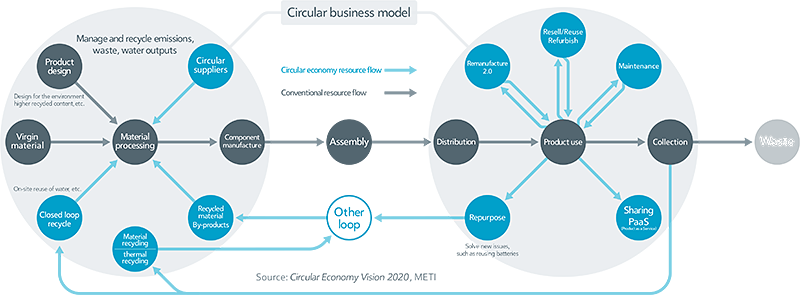
Initiatives
Promote Effective Resource Use
Reduced Packaging Materials: Expansion of the Introduction of Returnable Racks
As part of Isuzu Group's efforts to reduce environmental impact throughout logistics, we are promoting the expansion of environmentally friendly packaging materials, taking into account the entire process from packaging and shipping within the Group to disposal at overseas factories. In particular, since 2017, we have been advancing the introduction of returnable racks, which can be used repeatedly and are available for all destinations, and gradually expanding their use in the transportation of parts both in Japan and at overseas plants. The expanded use of returnable racks has enabled us to reduce the use of one-way racks for packaging knockdown (KD) parts, which previously became waste at overseas assembly plants.
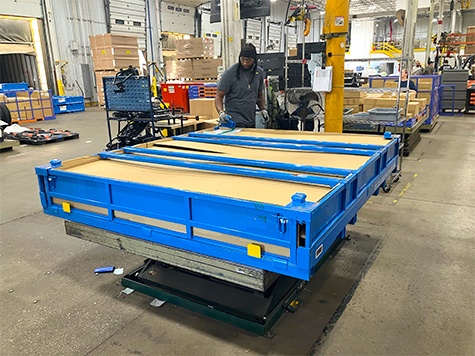
The previously wooden, one-way cab racks were switched to iron-made returnable racks. This eliminated the need for tasks such as removing nails during wood disassembly at the time of disposal, thereby improving safety during operations.
Additionally, starting in fiscal 2022, to make use of the upper space that arises when loading completed cabs into containers, we developed returnable parts racks that fit under the cab racks. This improved container fill rates through stacking. By loading large parts such as axles and parts that were previously shipped using other containers onto these returnable parts racks, we have been able to reduce the use of 40-foot shipping containers by approximately 300 containers annually, contributing not only to resource conservation but also to the reduction of GHG emissions during transportation.
In fiscal 2020, we also developed lightweight returnable racks that reduced individual rack weight by 33% compared to conventional ones, as well as two types of racks of varying heights to increase container fill rates. In fiscal 2024, the deployment of these racks to major destination countries was completed. Also, a new cab returnable rack, which has been developed for a new model vehicle type since fiscal 2025, was additionally introduced in fiscal 2026.
We will continue to promote the effective use of returnable materials to reduce environmental impact and improve logistics efficiency.
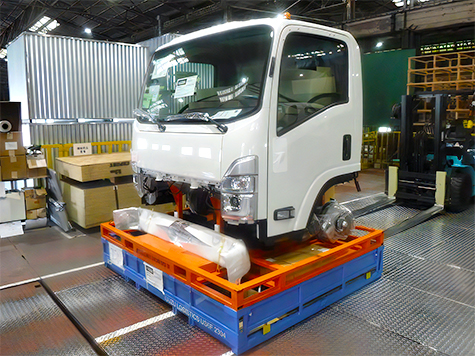
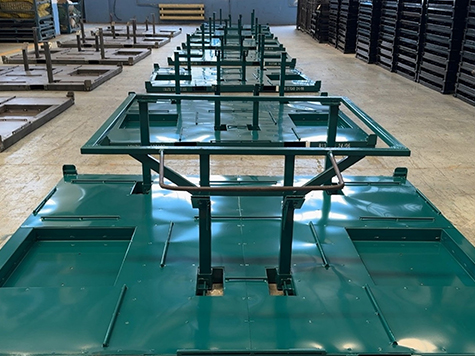
Reduction of Packaging and Packing Materials: Discontinuation of the Use of Stretch Film
As part of its resource recycling activities, the Isuzu Group is working to reduce the amount of materials used for transportation between domestic locations. When transporting parts between two locations in Japan, a two-tiered cart is used, and a rain cover is placed over the cart to protect it from rain during outdoor work. In the past, stretch film was wrapped around the rain cover to prevent the packaged parts from falling through the cover, and the stretch film was disposed of after transportation. In addition, lifting the stretch film, which is 50 cm in height and weighs 2 kg, and wrapping it around the two-tiered cart twice worsens the pack posture of workers, causing pack pain, and there is a risk of parts falling. Therefore, starting in October 2024, the stretch film has been replaced by a lashing belt that can be used repeatedly. This makes operations easier by simply wrapping two lightweight lashing belts around the cart, and in terms of quality management, it eliminates the possibility of parts falling from the cart. This initiative has reduced the amount of stretch film waste by approximately 5 tons per year and improved operational efficiency.
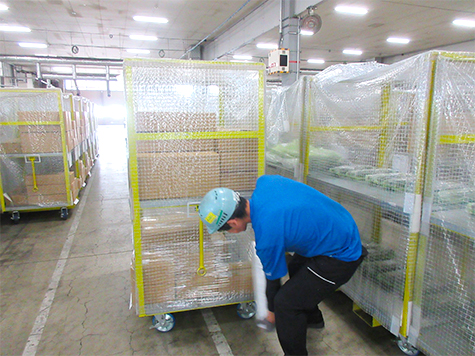
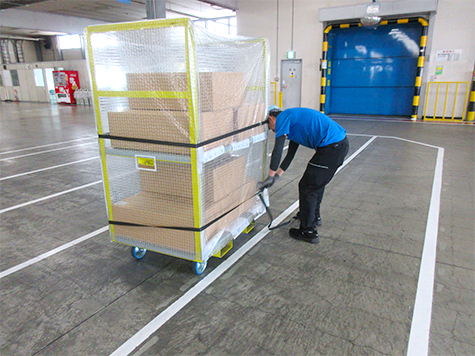
Reduction of Packaging and Packing Materials: Switching from Plastic Fixing Material to Corrugated Cardboard Fixing Material
The Isuzu Group examines environmentally friendly packaging methods on a daily basis in order to create a sustainable society.
In fiscal 2025, with the first production of KD parts for EV vehicles, we started full-scale development and adoption of environmentally friendly packaging materials in line with the vehicle concept.
In the past, when designing packaging specifications, plastic foam, which is derived from petroleum, was mainly used as a fixing material for parts, but we worked on the introduction of corrugated cardboard fixing materials in line with the EV vehicle concept.
Although there were many challenges to be overcome in terms of quality and cost, we were able to reduce plastic foam material by 308 kg per year by introducing corrugated cardboard fixing material for eight parts including radiators of EV vehicles starting in June 2024.
We will continue to incorporate environmentally friendly designs and contribute to reducing the impact on the environment in packaging.
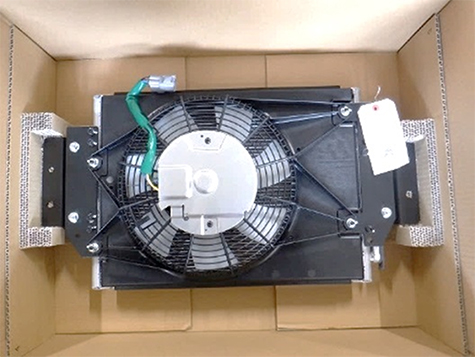
Effective Utilization of Water Resources
Isuzu's business activities entail the consumption of a large quantity of water in vehicle manufacturing, plant maintenance, effluent treatment and many other situations.
To conserve limited water resources, we are working to reuse process water and wastewater, as well as to reduce water usage.
Initiatives Towards a Circular Economy
Maintenance Leases Utilizing Remanufactured Units
Isuzu provides maintenance lease services for reconditioned vehicles (remanufactured unit vehicles), using Isuzu's remanufacturing*1 technology. This technology restores reusable engines, transmissions, and other major components to like-new functionality after short-term, high-performance leasing.
In addition to reconditioned heavy-duty trucks, the GIGA type-Re, we started offering medium-duty trucks, the FORWARD type-Re, in March 2025 in response to customer requests.
In the restoration process of remanufactured unit vehicles, the advanced genuine maintenance tool PREISM is used to assess the vehicle's condition and detect data on parts that need replacement.
By reusing parts, we not only contribute to resource circulation but also achieve a reduction in CO2 emissions during manufacturing by approximately 76 tons per vehicle for heavy-duty trucks*2 and 28 tons per vehicle for medium-duty trucks*3 compared to new vehicles. This initiative supports our goal of reducing greenhouse gas (GHG) emissions.
In the future, we intend to utilize our implementation experience and knowledge to expand our services to other types of vehicles and equipment, such as tractor heads and refrigerated freezer trucks, which are also requested by our customers.
- *1The term “remanufacturing” refers to making used products into like-new products through disassembly, parts replacement, etc. following the collection of used products.
- *2Calculated based on a heavy-duty GIGA truck that has traveled approximately 1 million kilometers over five years.
- *3Calculated based on a medium-duty FORWARD truck that has traveled approximately 0.7 million kilometers over five years.
Promotion of Rebuilt Products
The Isuzu Group is engaged in rebuilding used engines and parts by disassembling, cleaning, inspecting, and replacing worn parts with new ones before reassembling them.
We sell remanufactured products that meet the same inspection standards as new parts from the production line under the Isuzu genuine recycled parts brand E-PARTS.
Isuzu Engine Manufacturing Hokkaido Co., Ltd. rebuilds engines and parts to reduce resource input and manufacturing energy. In the future, we will establish evaluation standards for parts recycling technologies and recycled parts, improve the parts recycling rate, and promote and expand rebuilding to further reduce resource and energy input.
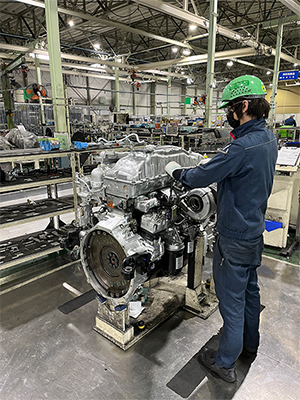
Promoting Recycling
Compliance with the Automotive Recycling Law
The Isuzu Group is committed to reducing the total amount of waste generated by its business activities and promoting the effective use of waste to minimize and control emissions, including valuable materials.
We handle end-of-use vehicles according to regulations in each country, and in Japan, we promote recycling under the Act on Recycling, etc. of End-of-Life Automobiles. This includes recycling the three designated items (ASR*, airbags, and chlorofluorocarbons).
For the recycling of ASR, we operate the Automobile Shredder Residue Recycling Promotion Team (ART) in collaboration with 12 other automobile manufacturers to ensure proper handling of ASR.
- *Automobile Shredder Residue

